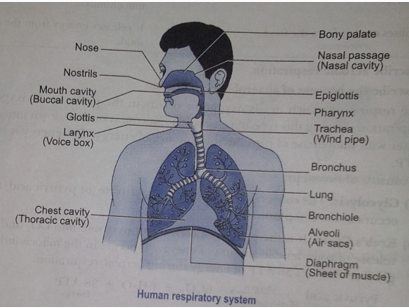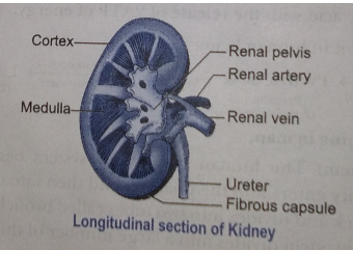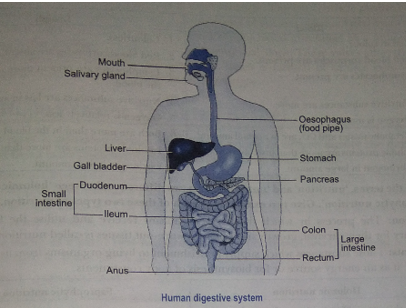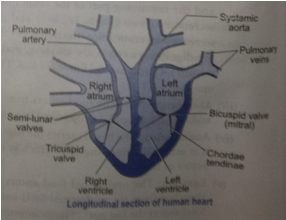Long Answer Questions - 5 Marks
Que 1. What is the different between autotrophic nutrition and heterotrophic nutrition?
Ans.
|
Autotrophic nutrition |
Heterotrophic nutrition |
|
2. The raw materials required for preparation of food are co2 and H2O. |
1. The organisms which cannot make their own food and depend directly or indirectly on autotrophs for their survival are called heterotrophs, e.g., animals and fungi. Heterotrophic nutrition refers to the process of nourishing, namely by obtaining food from other organisms, for their own growth and maintenance. 2. Heterotrophs are directly or indirectly dependent on autotrophs. |
Que 2. Describe the glands involved in the digestive system.
Ans.
|
S.No. |
Organ |
Gland |
Secretion |
Enzymes |
Substrate |
End Product |
|
1. |
Mouth |
Salivary |
Saliva |
Salivary amylase |
Starch |
Maltose |
|
2. |
Stomach |
Gastric |
Gastric juice |
1. Pepsin |
Proteins |
Peptones |
|
3. |
Duodenum |
1. Liver |
Bile juice |
No enzyme
|
Fat |
Emulsification of fats (alkaline medium) |
|
4. |
Small intestine |
Intestinal |
Intestinal juice |
1. Erepsin |
Peptones, and Peptides |
Amino acids |
Que 3. What are the common features between all the respiratory organs? Explain the mechanism of gaseous exchange between tissues and blood.
Ans. Common features between all the respiratory organs are:
(i) All the respiratory organs have large surface areas to get enough oxygen.
(ii) All the respiratory organs are thin-walled for easy diffusion of gases and substances.
(iii) All the respiratory organs (like skin, lungs, gills) have a rich supply of blood for transporting respiratory gases.
The mechanism of gaseous exchange between tissues and blood is as follows:
(i) The blood reaching the tissues has higher concentration of oxygen than in the cell so it gets diffused into the cells.
(ii) The carbon dioxide, which is formed in the cells, gets accumulated in higher concentration as compared in the blood, so it easily diffuses into the blood.
(iii) The blood with CO2 takes this gas to the lungs, from where it is expelled out during exhalation.
Que 4. Explain the nutrition process in an Amoeba.
Ans. The mode of nutrition in Amoeba is holozoic.

The various steps involved in the process of nutrition are:
(i) Ingestion: Amoeba ingests food with the help of its finger-like extensions, called pseudopodia.
When a food particle approaches Amoeba, it forms pseudopodia around it and forms a food vacuole inside the Amoeba.
(ii) Digestion: Various enzymes from the cytoplasm enter into the food vacuole and break them down into simple soluble molecules.
(iii) Absorption: The simple soluble food is absorbed by cytoplasm of amoeba from food vacuoles through the process of diffusion.
(iv) Assimilation: Amoeba cell obtains energy from the absorbed food through respiration. This energy is utilised by Amoeba for its growth and repair of the body.
(v) Egestion: When a considerable amount of undigested food gets collected inside Amoeba, its cell membrane ruptures and throws out the undigested food.
Que 5. Give the role of liver in the human beings.
Ans. Liver is the largest gland in human beings.
Its main functions are as follows:
(i) It secretes bile juice which makes the medium of the food alkaline and also emulsifies fat.
(ii) It stores the excess of glucose in the form of glycogen.
(iii) old worn-out RBCs are broken down in liver cells. Their haemoglobin is changed into bile pigments.
(iv) The ammonia is produced as a result of metabolism of amino acids. It is highly toxic. The ammonia combines with CO2 and is converted into urea (less toxic).
(v) It stores vitamins, iron and copper.
(vi) It produces fibrinogen and helps in blood-clotting.
(vii) It produces heparin which does not allow the clotting of blood inside the blood vessels.
(vii) It regulates the volume of blood to some extent.
(ix) RBCs are produced at the foetus stage by the liver.
Que 6. Distinguish between breathing and respiration.
Ans.
|
Breathing |
Respiration |
|
1. The process of obtaining oxygen and releasing carbon dioxide is called breathing. |
1. The process of releasing energy from food is called respiration.
|
Que 7. (i) Describe aerobic respiration.
(ii) Describe the process of anaerobic respiration.
Ans. (i) The respiration which needs oxygen or occurs in the presence of oxygen is called aerobic respiration. During this type of respiration, glucose is broken down into carbon dioxide and water with the release of considerable amount of energy. The energy is stored in the form of ATP.
It consists of two steps:
(a) Glycolysis: The conversion of glucose into pyruvate (or pyruvic acid) is called glycolysis. It occurs in the cytoplasm
(b) Kreb's Cycle: It is the process of converting pyruvate into CO2 and H2O along with the release of considerable amount of energy. It occurs in the mitochondria. One molecule of glucose liberates 38 ATP of energy during aerobic respiration.


(ii) The respiration which takes place in the absence of oxygen is called anaerobic respiration. During this respiration glucose is broken down into ethyl alcohol and CO2 with release of very small amount of energy. In anaerobic respiration, one molecule like yeast, etc.

In human beings, the energy is obtained by aerobic respiration but sometimes anaerobic respiration occurs in muscles during vigorous exercise when oxygen gets consumed faster than its supply by the blood. During the anaerobic respiration in the muscles the glucose is converted into lactic acid with the release of 2 ATP of energy.

Que 8. Explain process of breathing in man.
Ans. Human respiratory system: The human respiratory system begins from nose cavities called
nostrils. The air from cavity enters into the pharynx and then into the trachea (or wind pipe). The trachea runs down the neck and divides into two tubes called bronchi. Each bronchi is connected to a lung. In the lungs each bronchi divides into a large number of thin tubes called bronchioles. The bronchioles have a tiny air sac at their ends called alveoli. It is in the alveoli where exchange of gases takes place.
Mechanism of breathing:
(i) When we breathe in air, the diaphragm contracts which results in the increase in volume of chest cavity. Due to this expansion of chest cavity, the air pressure in the lungs decreases. Thus, air from outside rushes into the lungs through nostrils, trachea and bronchi Therefore, air sacs of lungs get filled with air when we breathe in. The exchange of gases between alveoli and blood takes place by the process of diffusion.

(ii) Now, the air present in air sacs of the lungs is rich in CO2. When we breathe out air, the diaphragm relaxes which results in the decrease in volume of chest cavity. The contraction pushes the air from the lungs into the trachea, nostrils and then out of the body into air. Breathing in air is called inhalation and breathing out air is called exhalation.
Mechanism of gaseous exchange during respiration: The oxygen is carried by blood to all the parts of the body. As the blood passes through the tissues of the body, the oxygen from the blood diffuses into the cell, whereas the CO2 which is produced during respiration diffuses into the blood and is carried to the lungs.
Que 9. Describe the structure of human kidney.
Ans. Kidneys are bean-shaped and located at the back of abdomen, one on either side of backbone. Its inner concave surface has a depression called hilum through which renal artery enters and renal vein leaves the kidney. Kidney has two regions: outer cortex and inner medulla. Each kidney has a large number of filtering units called nephrons.

Que 10. Describe the process of digestion of food in human beings.
Ans.

The various processes involved in the digestion of human beings are:
(i) Ingestion: Through the help of mouth human beings ingest food.
(ii) Digestion: The teeth helps in physical digestion of food. In mouth there are salivary glands, which secretes saliva, in which salivary amylase enzyme is present which digest the starch present in food into maltose sugar, i.e., the digestion of carbohydrate starts from mouth itself. Mouth opens into a small funnel-shaped area called pharynx which leads to a long tube called oesophagus, whose wall is highly muscular. When the slightly digested food enters into oesophagus the contraction and expansion movement of its wall, takes place, which is known as peristaltic movement. This movement helps the food to move towards the stomach. Usually, in oesophagus there is no digestion of food. From the oesophagus the food enters into the stomach. In the stomach there is secretion of gastric juices which is a mixture of hydrochloric acid, pepsin (protein digesting enzyme) and mucus. Now, the partially digested food enters from stomach into the small intestine's wider part which is known as duodenum and the remaining part of the small intestine is termed as ileum. The duodenum, receives secretions of two glands, i.e, liver and pancreas. Liver secretes bile pigments and pancreas secretes pancreatic juice which digestes the proteins, carbohydrates and emulsified fats. Here the digestive enzymes are amylase, maltose and invertase for digesting the carbohydrates,
trypsin for proteins and lipase for fats. Thus, food is completely digested in ileum part of small intestine.
(iii) Absorption: Now, the food enters from duodenum into ileum part of small intestine where millions of finger-like projections known as villi are present which absorb the food.
(iv) Assimilation: The blood carries the digested and dissolved food to all parts of the body, where it is assimilated into the cells which is used for obtaining energy as well as for growth and repair of the body.
(v) Egestion: The undigested food enters into the large intestine's wider part, where water is absorbed from the undigested food and the food becomes solid. Now, this solid undigested food enters the last part of large intestine known as rectum through which it moves out from the body.
Que 11. Different between blood and lymph.
Ans.
|
Blood |
Lymph |
|
1. Red in colour. 2. Red blood corpuscles are present. 3. Lymphocytes are present. 5. Oxygen is more. 6. Metabolic wastes and CO2 are in normal amount. 7. Soluble proteins are more than insoluble proteins. 8. Fibrinogen in large amount. |
1. Colourless 2. Red blood corpuscles are absent. 3. Lymphocytes are present more in number than the blood. 4. Nutritive substances are less in amount. 5. Oxygen is relatively less. 6. Both are more than in the blood. 7. Insoluble proteins are more than soluble ones. 8. Fibrinogen in less amount. |
Que 12. Define the terms, 'nutrition' and 'nutrients. List two differences between 'holozoic nutrition' and 'saprophytic nutrition'. Give two examples of each of these two types of nutrition.
Ans. Nutrition: The process by which the living organisms receive and utilise the food materials necessary for their survival, growth and repair of worn-out tissues is called nutrition.
Nutrients: Those substances which supply nourishment to living organisms from its surroundings and use it as an energy source or for biosynthesis of body constituents.
|
Holozoic nutrition |
Saprophytic nutrition |
|
1. In this type of nutrition solid and complex organic food is directly taken into the body.
|
1. In saprophytic nutrition, the organism obtains nutrients from the dead and decaying organic matter. The food is digested outside the body of the organism and then absorbed.
2. Saprophytic nutrition takes place by absorption of break-down products.
|
Que 13. Describe internal structure of a human heart.
Ans. The two auricles or atria are thin-walled and are separated from each other by a thin inter-atrial septum. The right atrium receives venous (deoxygenated blood having very little O2) from the entire body through a superior and inferior vena cava. The left smaller atrium receives oxygenated blood from the lungs through four pulmonary veins. The two auricles (atria) are separated from the ventricles by two apertures guarded by membranous valves. The valve separeright atrium from right ventricle is called right atrio-ventricular valve or tricuspid valve made up of three flaps. The valve separating left atrium from left ventricle is called left atrio-ventricular valve or mitral alve, formed of two flaps. These valves are valves attached with fine cords with the papillary muscles of the ventricular wall. These valves only allows flow from auricles into ventricles and not in opposite direction.
Both the ventricles are separated from each other by a thick inter-ventricular septum. The wall of left ventricle is much thicker than that of right ventricle. The left ventricle pushes blood into aorta which supplies blood to entire body. The opening of aorta is also guarded by a valve formed of 3 semilunar flaps. The right ventricle pumps venous blood into lungs by a pulmonary aorta. Its opening is also guarded by a valve, having 3 semilunar flaps. These valves allow the flow of blood from ventricles into the aorta and not back. Heart is formed of cardiac muscle fibres, which rhythmically contract the heart without feeling fatigue.


